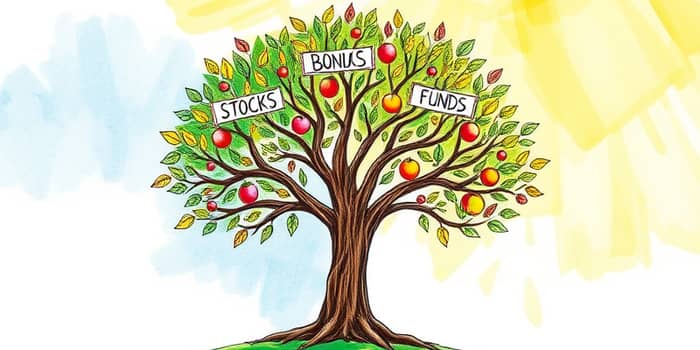Embarking on a financial journey can feel daunting, but understanding the fundamental building blocks of investing unlocks a world of opportunity. In today’s dynamic markets, knowledge empowers you to make wiser decisions for long-term success and navigate uncertainties with confidence.
This comprehensive guide breaks down complex concepts into clear, actionable insights, inspiring you to chart a path toward your financial goals.
Understanding Stocks: Growth Engine
Stocks represent equity ownership in a company. When you purchase a share, you become a partial owner, entitled to dividends and potential capital gains. Over decades, stocks have delivered an average annual return of around 10%, reflecting their long-term growth potential.
However, this growth comes with volatility. Prices can swing in response to earnings reports, economic shifts, and market sentiment. Embracing stock investing means accepting short-term fluctuations in pursuit of substantial wealth creation over time.
- Common stocks: Voting rights, variable dividends
- Preferred stocks: Fixed dividends, no voting rights
- Exchange trading: High liquidity, real-time pricing
- Risk factors: Market sentiment, business performance
Demystifying Bonds: Foundations of Stability
Bonds function as loans you extend to entities—governments, municipalities, or corporations—in exchange for regular interest payments and principal repayment at maturity. They offer a steady stream of income and tend to be less volatile than stocks.
Depending on the issuer and credit rating, bonds span a spectrum from ultra-safe government securities to higher-yield corporate debt. Understanding interest rate dynamics is crucial: as rates rise, existing bond prices typically fall, and vice versa.
- Government bonds: Low risk, modest returns
- Municipal bonds: Tax advantages, community funding
- Corporate bonds: Investment-grade vs. high-yield
- Key influences: Interest rates, inflation, credit risk
Pooled Power: Mutual Funds and ETFs
Mutual funds and exchange-traded funds (ETFs) pool money from many investors to build portfolios of stocks, bonds, or other assets. This diversification mitigates risk and offers professional management.
Mutual funds trade once per day at net asset value, while ETFs trade like stocks throughout market hours. Both come in various strategies:
- Stock funds: Equity-focused growth potential
- Bond funds: Income-oriented stability
- Balanced funds: Mixed asset allocation
- Target-date funds: Automatic glide path for retirement
Building a Balanced Portfolio
Crafting a portfolio that aligns with your goals involves blending stocks, bonds, and funds to balance growth and preservation. Your ideal mix depends on your risk tolerance, time horizon, and financial objectives.
Younger individuals often lean toward a heavier stock allocation for maximum growth potential, while those nearing retirement shift to bonds to protect capital and generate income.
- Assess your risk tolerance and time frame
- Rebalance periodically to maintain target allocation
- Use funds or ETFs for instant diversification
Benchmarking and Performance Metrics
Tracking performance against standard indexes helps you gauge success and make informed adjustments. Popular benchmarks include:
Comparing your portfolio to these benchmarks provides clarity on performance, risk-adjusted returns, and areas for improvement.
Navigating Risks and Rewards
Every investment carries risks. Stocks can plummet in bear markets, bonds face interest rate and default risks, and funds mirror the ups and downs of their underlying assets. However, disciplined strategies and diversification can reduce overall portfolio volatility and protect your wealth.
Key risk management techniques include spreading assets across uncorrelated investments, setting stop-loss limits, and maintaining an emergency cash reserve to avoid forced sales during downturns.
Charting Your Financial Journey
Embarking on investing is more than numbers and charts; it’s a journey of personal growth and empowerment. By embracing the core principles of stocks, bonds, and funds, you equip yourself to make informed decisions under pressure and steadily progress toward your dreams.
Start by setting clear, measurable goals—whether buying a home, funding education, or retiring comfortably. Then, design a portfolio that reflects your unique circumstances, revisit it regularly, and stay the course through market cycles.
Your financial future is a story you write with each investment choice. With knowledge as your guide, you can transform uncertainties into opportunities and build the life you imagine.
References
- https://abacusplanninggroup.com/insights/2013/06/understanding-the-difference-in-stocks-bonds-mutual-funds-and-etfs
- https://www.nerdwallet.com/article/investing/stocks-vs-bonds
- https://finred.usalearning.gov/Saving/StocksBondsMutualFunds
- https://www.synchrony.com/blog/bank/stocks-vs-bonds
- https://smartasset.com/investing/stocks-vs-bonds-vs-mutual-funds
- https://www.investopedia.com/terms/i/investing.asp
- https://www.investopedia.com/ask/answers/09/difference-between-bond-stock-market.asp










